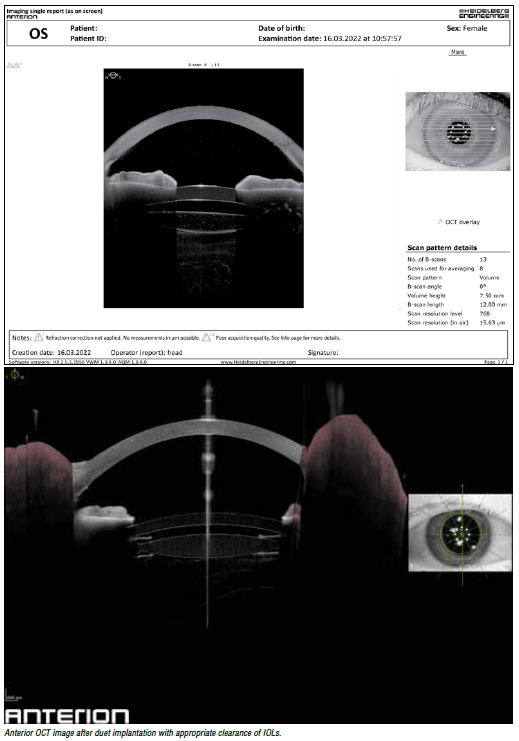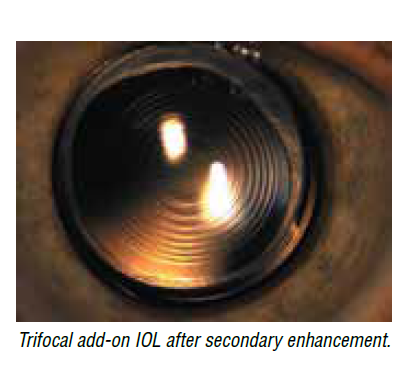Add-on IOLs—a versatile choice for primary implantation or postsurgical enhancement. Cheryl Guttman Krader reports.
IOL exchange in pseudophakic patients is an option for correcting refractive surprises and changing the optical situation. As an alternative, implanting an add-on IOL in the sulcus offers several advantages – doing so at the time of cataract surgery in a so-called “duet procedure” can also be a valuable approach, said Michael Amon MD, PhD.
“An add-on IOL implanted in a secondary enhancement procedure can be used to correct ametropia in the case of a refractive surprise or to convert a pseudophakic patient with a monofocal IOL to multifocal status. Compared to IOL exchange, implanting an add-on IOL is surgically less demanding and less risky, and the power calculation is more straightforward,” he told a symposium.
He noted implanting an add-on IOL during the primary operation is an attractive adjustable option for children or patients expected to have changing refraction. It is also a reversible option for patients interested in presbyopia correction. The add-on IOL can be more easily explanted than a capsular bag IOL both early or later. Therefore, patients who initially choose presbyopia correction can be changed to monofocal status if they fail to neuroadapt, are bothered by photic phenomena, or develop ocular pathologies such as age-related macular degeneration or diabetic macular oedema that affects their quality of vision.
IOL EXCHANGE
Performing IOL exchange can present a technical challenge because it involves capsular surgery. Therefore, the exchange procedure is accompanied by a risk of vitreous loss, and that is particularly true in the not uncommon situation where the patient has already undergone Nd:YAG laser capsulotomy, Prof Amon said.
The exchanged IOL will ideally be a posterior chamber lens implanted in an intact capsular bag. A posterior chamber IOL may be placed on capsular remnants or in the sulcus if the ideal is not possible. In some situations, the lens may need to be fixated, which can be done to the sclera or iris using sutures, a tunnelling technique, or flanging of the haptic.
“For IOL calculations with sulcus placement, surgeons will need to take into account the refraction is affected by the change in IOL position,” Prof Amon advised.
ADD-ON IOL SURGERY
The first add-on lenses used in the 1990s were implanted in the capsular bag, either in the primary procedure to correct high hyperopia or myopia, or secondarily to correct pseudophakic ametropia. However, they were associated with several problems and complications, including intralenticular membrane formation, hyperopic defocus, pigment dispersion, inflammation, IOP elevation, and haemorrhage.
“Modern add-on IOLs are designed to avoid these issues. Made of hydrophilic acrylic, they are highly biocompatible with uveal tissue. In addition, they have a large optic diameter providing IOL overlap, a round edge that minimises dysphotopsia, a concave posterior surface to avoid hyperopic defocus, and haptics designed for uveal clearance and stable centration.”
With currently available add-on IOLs (Cristalens Reverso®, Rayner SulcoFlex®, and Medicontur 1stQ AddOn®), surgeons can choose optic designs that include aspheric monofocal, refractive bifocal, diffractive bifocal or trifocal, toric, and multifocal toric. In addition, there are add-on IOLs used for special indications. They include the Morcher Xtra, which reduces irregular astigmatism and provides extended depth of focus and magnifying lenses (iolAMD Eyemax and Medicontur 1stQ AddOn SML). Although it is off-label and these IOLs have an anterior vault, some surgeons, unfortunately, also use a phakic IOL as an add-on option, Prof Amon said.
IOL power calculation in cases of secondary add-on IOL implantation can be done with the refractive vergence formula that uses data on spherical equivalent, keratometry, and anterior chamber depth. An easier option when the add-on is being used to correct postoperative ametropia ±7.0 D is to multiply the spherical equivalent by 1.5 in cases of hyperopia or by 1.2 in myopia, he said.
DOCUMENTED PERFORMANCE
Clinical studies reported by Prof Amon and others show the safety and effectiveness of modern add-on lenses.
“We have shown that the add-on lenses are stable in the sulcus and maintain better centration than in-the-bag IOLs, which can change position because of capsular contraction. Studies with toric add-on IOL to correct residual refractive error after primary implantation showed good results, but rotation of the add-on IOL occurred in 10% of cases. In these cases, the sulcus-placed IOL can be easily repositioned. Personally, I prefer to suturefixate the haptic of the add-on IOL in such cases,” he explained.
Multifocal add-on IOLs for presbyopia correction have also shown good results.
“Importantly, results from optical bench studies show there are equal reflections beside the additional surfaces, and the optical quality achieved with both the in-the-bag and add-on lens is similar to that associated with a single capsular bag multifocal IOL,” Prof Amon said.
This presentation was made at the ESCRS Virtual Winter Meeting 2022.
Michael Amon MD, PhD is Chair of the Eye Department, Sigmund Freud University Vienna and Academic Teaching Hospital of St John, Vienna, Austria.
amon@augenchirurg.com




